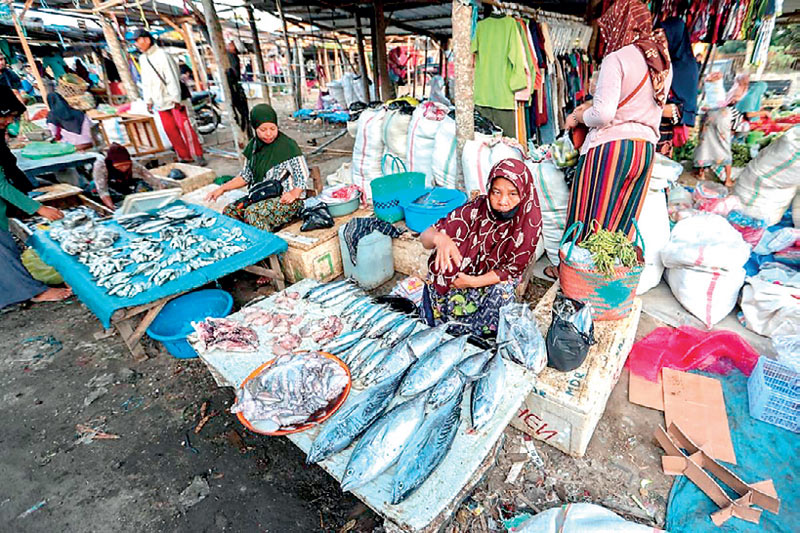Wednesday Dec 24, 2025
Wednesday Dec 24, 2025
Friday, 7 January 2022 00:53 - - {{hitsCtrl.values.hits}}

Quick action by governments needed to keep people fed during the pandemic – Photo: ADB
By Manisha Pradhananga, Matteo Lanzafame, Irfan A. Qureshi
ADB.ORG: COVID-19 has resulted in broad impacts on food security in Asia. Policymakers must respond quickly and aggressively to these challenges to avert long-term damage from this emerging crisis.
The pandemic hit Asia’s food supply hard, causing a sharp increase in the number of people unable to access enough food to stay healthy and feed their families. Women, children, and the poor have suffered most.
COVID-19 has unsettled food supply chains in various ways. In the initial days of the pandemic, uncertainty surrounding imminent lockdowns across the region led to panic buying, temporary shortages, and price spikes. Disruptions to domestic and international food supply chains—which emerged as rising health risks led to major travel restrictions—undermined food availability and accessibility, in particular of perishable goods.
Micro, small, and medium-sized enterprises were battered by lost sales, higher production costs to ensure safe working environments, and difficulty accessing inputs, equipment, and food distribution systems in Asia’s low- and middle-income economies.
These disruptions led to a sharp increase in food insecurity – defined as having physical, social, and economic access to food that meets dietary needs and food preferences. According to the UN’s Food and Agriculture Organization, the number of people experiencing severe food insecurity globally rose by 148 million in 2020 to 928 million — 12% of the global population.
The impact of the pandemic on food security has also been sharp within economies. While the divide is clear across the income strata, new fault lines have emerged as well. For instance, urban centres have been more severely affected because of higher population density, a disproportionately larger share of COVID-19 cases and outbreaks, and stricter restrictions on movement. Among the worst affected have been the urban poor, who largely rely on insecure jobs in the informal sector and spend a substantial portion of their income on food.
The pandemic has also intensified food insecurity for women and vulnerable groups. The share of women affected by moderate or severe food insecurity was 10% higher than that of men in 2020, up from 6% in 2019. Together with a lower availability of nutritious food and disrupted health and nutrition services, income losses associated with the pandemic are projected to expose an additional 9.3 million children worldwide to wasting by 2022, 2.6 million to stunting, and 168,000 to death, and induce 2.1 million maternal anaemia cases.
It is still unclear whether—or to what extent—the economic recovery in 2021 will result in a decline in food insecurity. What we know is that COVID-19 has exacerbated food insecurity in the region, which may have lasting impacts in 2021 and beyond. Policymakers must respond quickly and aggressively to overcome these challenges.
In the short run, it is critical to protect the most vulnerable members of society through food assistance and other social transfers. Many Asian economies are already implementing food assistance programs. In the Philippines, the Department of Social Welfare and Development distributed food packs as part of a program aimed at the poor, people with disabilities, and the elderly living in hard-to-reach areas or far from food retail stores. Many other Asian economies are also implementing food assistance programs, which may require active fiscal adjustments in several regional economies.
The COVID-19 pandemic also highlights the importance of building capacity to face food-security challenges in the medium- to long-term. A proactive response is especially needed in the context of climate change and the expected rise in the frequency and scale of extreme weather events.
Asia is home to 350 million smallholder farmers, who have access to limited resources, particularly in the face of adverse events. Estimates by FAO suggest that between 2008-2018 agriculture absorbed 63% of the damage and loss caused by climate-related disasters across all economic sectors in developing countries.
Alarmingly, between 2003 and 2013, six of the world’s 10 climate-related disasters most damaging to agriculture were in Asia. They include floods in agrarian economies such as Pakistan, which caused approximately $ 5.3 billion in agricultural damage and loss in 2010 and $ 1.9 billion in 2011.
Policy actions should focus on building resilient food systems and farming livelihoods, by helping farmers prevent, prepare, and adapt to weather shocks more effectively. Investing in early warning systems—based on advanced spatial information technology combined with detailed crop models, machine learning algorithms, ground data on agricultural production and management—can help farmers anticipate extreme weather events and plan accordingly. In 2019, timely information on floods in northern Bangladesh helped communities and the government prepare and secure necessary supplies, massively reducing economic losses.
Finally, food security issues are inexorably tied to agricultural policies. To provide nutritious food that is affordable for all, agriculture policy in the region will need to promote productivity growth while ensuring environmental sustainability.
Manisha Pradhananga is an Economist – Economic Research and Regional Cooperation Department, ADB
Matteo Lanzafame is a Senior Economist – Economic Research and Regional Cooperation Department, ADB
Irfan A. Qureshi is an Economist – Economic Research and Regional Cooperation Department, ADB